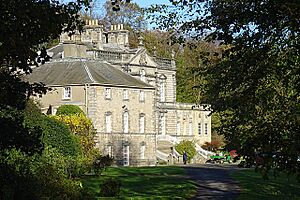The Drum, Edinburgh facts for kids
Quick facts for kids The Drum, Edinburgh |
|
|---|---|

Entrance front of The Drum
|
|
| Built | 1726–1734 |
| Built for | John Somerville, 13th Lord Somerville |
| Architect | William Adam |
|
Listed Building – Category A
|
|
| Designated | 14 July 1966 |
| Reference no. | LB28052 |
|
Inventory of Gardens and Designed Landscapes in Scotland
|
|
| Designated | 1 July 1987 |
| Reference no. | GDL00356 |
| Lua error in Module:Location_map at line 420: attempt to index field 'wikibase' (a nil value). | |
The Drum is a beautiful old country house and estate near Edinburgh, Scotland. It was built in the 1700s. You can find it between the areas of Gilmerton and Danderhall, about 4 miles south-east of Edinburgh city centre.
For many years, The Drum was the main home of the Lords Somerville. They built a house here in the 1500s. Later, in the 1720s, a famous architect named William Adam designed the grand house you see today. The Somerville family sold the house in the early 1800s. It is still a private home today.
Contents
The Drum's Story: A Look Back in Time
Long ago, in the Middle Ages, the land around The Drum was part of a royal hunting forest. This forest was called Drumselch. It stretched all the way north to Holyroodhouse.
The Herring family owned these lands until the 1300s. Then, Sir Walter de Somerville married Geilles Herring. Through this marriage, he gained half of the Gilmerton estate, which included the lands of Drum. The Drum stayed with the Somerville family until the year 1800.
Building the First House
In the 1500s, there was a disagreement in the Somerville family. Two parts of the family argued over who owned Gilmerton and The Drum. This problem was solved in 1578 after many years of legal talks. Hugh Somerville, the 7th Lord Somerville, won the case.
Lord Somerville then moved back to The Drum. In 1584, he hired a builder named John Mylne to construct a new house. The house was built between June 1584 and October 1585. It was damaged by fire a few times but was always rebuilt.
The 11th Lord Somerville described the house in 1679. He said it had "few, but fair and large" rooms. He also noted that the entrance and staircase were "extremely ill-placed." He thought the outside looked "like a church."
Designing the Grand House We See Today
In 1726, James Somerville, the 13th Lord Somerville, hired William Adam to design the current house at The Drum. The new house actually includes the ground floor of the old 1500s mansion in its west side. The plan was to build a matching east side, but it was never finished.
Above the main entrance, you can see the Somerville family's coat of arms. It also shows the arms of Lord Somerville's first wife. Inside, above the fireplace, the Somerville arms are shown with his second wife's. This tells us the inside was decorated after 1736.
The design of the house is called Palladian. This style uses ideas from ancient Roman buildings. The house has a special window in the middle and stone blocks that look rough. The inside has amazing stucco work, which is a type of decorative plaster.
The curved double staircase leading to the main entrance was added later, in 1782. William Adam also designed new parks around the house. He planned long paths that led to different buildings and monuments. Not many of these original features still exist today.
The Mercat Cross at The Drum
From 1756, the original Edinburgh Mercat Cross was located at The Drum. A mercat cross was a special stone pillar that marked a market place in a town. This cross was moved from Edinburgh's High Street to The Drum. It stayed there until 1866, when it was put back in Edinburgh. Now, a copy of the cross stands near the stables at The Drum.
Who Lives at The Drum Now?
In the early 1800s, the large estate was divided up. In 1862, John More Nisbett bought the house and much of its original land. His son, Hamilton More Nisbett, became an architect. He inherited The Drum in 1939 after his older brother passed away.
Hamilton More Nisbett ran his architecture business from The Drum. He also wrote a book about the house's history. The Drum is still owned and lived in by the More Nisbett family today.
The Drum's Special Status
The Drum is a very important building in Scotland. It is a category A listed building. This means it is protected because of its historical and architectural importance.
The parks around The Drum are also special. They are included in the Inventory of Gardens and Designed Landscapes in Scotland. This list names important gardens in Scotland. The Drum's parks are a great example of William Adam's formal garden style from the 1700s. Much of their original design is still there today.
Images for kids




